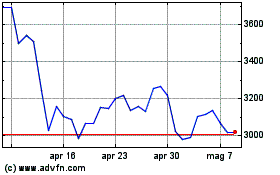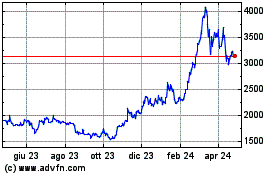Is The Bitcoin Price Manipulated? Expert Exposes The Truth
24 Febbraio 2025 - 2:30PM
NEWSBTC
In a new research report shared on X, Joe Consorti, Head of Growth
at Theya, has dispelled ongoing rumors alleging that the Bitcoin
price is being artificially held down. Consorti lays out a
comprehensive examination of on-chain data, pointing to the normal
cyclical behavior of long-term holders (LTHs) and their
profit-taking patterns as key drivers of bitcoin’s current trading
dynamic. Is The Bitcoin Price Currently Manipulated? One of the
core arguments Consorti addresses is the suspicion that “the boring
period of consolidation” might be engineered through hidden market
forces. In his words: “Claims of artificial price suppression is a
gold-era argument that doesn’t work in bitcoin, whose ledger is
auditable in real time, meaning we can see exactly who is buying
and selling through their own node on the network.” Consorti
underscores that any concerted effort to artificially cap Bitcoin
would be visible to on-chain observers. Instead, the data points to
a well-trodden pattern: after accumulating BTC in the lower price
ranges—between $15,000 to $25,000—LTHs sell portions of their
holdings into higher prices, redistributing coins to new market
participants who continue bidding bitcoin upward. “This is normal.
Those who held for years start offloading as price moves higher,
transferring coins to new buyers stepping in to bid the price to
even higher highs.” Related Reading: Bitcoin Faces Serious Price
Compression – What Happened Last Time According to Consorti,
Bitcoin has now entered its 100+ day consolidation range around
$95,000—a stretch he compares to previous multi-month consolidation
phases that eventually resolved in major price expansions. The
research provides a retrospective look at how LTHs behaved in
previous price climbs: “LTHs accumulated BTC from $15k to $25k,
before selling to new market entrants (short-term holders) who bid
the price up to the next ‘step’. They did the same from $25k to
$40k, from $40k to $65k, and from $65k to the ~$95,000 range we
find ourselves in now.” Consorti notes that LTHs have lately turned
back into net accumulators. Although the shift is slight, he
contends this behavior usually marks the tail end of consolidation
before another breakout. The researcher also points to a recent
$1.4 billion Ethereum hack on Bybit—allegedly the largest in
crypto’s history—as a factor momentarily knocking bitcoin off an
attempt to break out of its falling wedge pattern. Despite the
market disruption, bitcoin only slipped 1.75% on the day, which
Consorti says is a testament to the leading BTC’s “outright
strength” and diminishing correlation to broader crypto assets.
Overall, Consorti expects the falling wedge to “resolve itself by
the first week of March,” barring additional black swan events. He
also observes that Bitcoin’s current consolidation zone may stretch
beyond 101 days, cautioning that “maximum pain in the market” could
see it extend to 236 days, mirroring last summer’s protracted
consolidation period. Consorti also references the possible impact
of President Trump’s working group on Bitcoin, which is set to
decide on the viability of a Strategic Bitcoin Reserve by the end
of June. Should a final decision come sooner, he suggests it may
provide a major spark for the market—either bullish or bearish,
depending on the outcome. Spot ETF inflows, once seen as a main
propeller of Bitcoin’s price, have diminished since early January.
Although they still show 7–8 figure daily inflows, these are down
significantly from the 9–10 figure levels that occurred throughout
last spring and fall, hinting that other market forces, such as
institutional and on-chain dynamics, might be more influential in
this cycle’s price movement. Another topic is Bitcoin’s dislocation
from global M2 money supply, which had tracked the price with
uncanny accuracy for nearly 18 months. That correlation broke when
global M2 suggested a deeper downturn for bitcoin, yet BTC
continued to hover around $95,000. Now that M2 is edging upward
again on a weaker US dollar, the research suggests the possibility
of Bitcoin aligning for its next leg higher. Comparing Bitcoin to
gold with a 50-day lead likewise implies that gold’s recent
trajectory may “point to an upside resolution”, albeit less
precisely than M2 correlations. If this holds, a push towards
$120,000 appears plausible. Related Reading: Bitfinex Whale
Activity Increases As Bitcoin Approaches $100k—Further Surge Ahead?
Consorti concludes by shifting attention to the evolving landscape
of US Treasury (UST) demand. Major foreign holders such as China
and Japan have progressively reduced or flatlined their
positions—China’s holdings have reached a 2009 low of $759 billion,
while Russia has fully exited, and Japan remains at $1.06 trillion
for 13 years. “It’s not just China. Russia has fully exited USTs.
Japan, the largest foreign holder, has been sitting flat at $1.06
trillion for 13 years.” Meanwhile, the US Federal Reserve’s share
of outstanding marketable USTs has surged from 22% in 2008 to 47.3%
in 2025, stepping in as foreign demand wanes. But a new player is
joining the market in the form of stablecoins, which collectively
hold about $200 billion in Treasuries to back their dollar-pegged
tokens. According to Consorti, this stablecoin demand: “Could lower
long-term interest rates. The proliferation of stablecoins and
their use of Treasuries as a reserve asset means they’re
functioning like an entirely new foreign central bank.” He argues
that stablecoins effectively ensure fresh demand for Treasuries,
helping the US government offset declining foreign involvement and
sustain its borrowing needs. White House AI & Crypto Czar David
Sacks has publicly echoed this perspective, saying stablecoins help
maintain liquidity for US debt. At press time, BTC traded $95,645.
Featured image created with DALL.E, chart from TradingView.com
Grafico Azioni Ethereum (COIN:ETHUSD)
Storico
Da Gen 2025 a Feb 2025

Grafico Azioni Ethereum (COIN:ETHUSD)
Storico
Da Feb 2024 a Feb 2025
